 |
 The Virtual Corkscrew Museum's Weekly Newspaper |
 |
 |
 The Virtual Corkscrew Museum's Weekly Newspaper |
 |
|
Sunday, August 5, 2007 |
Number 471 |
Cork Retrievers
Did you ever push a cork into the bottle while trying to pull it out? Methods for removing corks from inside bottles have been around for a long, long time. This article is not intended to be all inclusive but to give an overview of cork retrievers. It spans the period from 1863 through 1940.
Proctor Patent
Morrill Patent
Bielefeld / Schwartz Patent
Stephen Proctor of York was granted British Patent No. 2,664 on
October 28, 1863 for his "Improved Instrument for Extracting Corks from Bottles". The sharp hooks are intended to cut up the cork if it is too large to go through the neck of the bottle and then smaller pieces can be drawn out by the hook. Or they can be shaken out if small enough. The Proctor extractor shows a graphic of the operation on the shank.
The inventions of Jesse Morrill of New York and Germans Francis Bielefeld and Charles Schwartz are the earliest U. S. Patents for this type of cork extractor. Morrill's U. S. Patent No. 42,784 was issued May 17, 1864. Morrill claimed "an improved cork drawer with grooved prongs, or with grooved and serrated prongs." His two prongs would sink into the sides of the cork taking up no more room than the cork coming through the bottle neck.
Bielefeld and Schwartz describe the operation of their device "We draw a cork from the body of a bottle by first inserting the metallic spring, then turning the bottle neck downward the cork falls into the neck, and by drawing the handle the cork is readily withdrawn." U. S. Patent No. 47,161 was issued April 4, 1865.
In C. Rosenberry's U. S. Patent No. 58,889 of October 16, 1866 he writes "The object of this invention is to produce a device by means of which corks could be extracted from bottles and other vessels conveniently, even if those vessels contain some liquid."
Rosenberry of Chicago twists four wires together forming a claw on the end of each. By passing the wires through a sliding ring, the claw can be closed to enter the bottle and opened to grip the cork.
One week after Rosenberry's patent, J. T. Ashley of Brooklyn, New York, was granted U. S. Patent No. 58,969 for a remarkably similar device working in the same manner as Rosenberry's but having a wooden "T" handle.
Seth Clapp came up with a little bit more complicated device in his "Improved Cork-Pull" U. S. Patent No. 78,485 of January 21, 1868. He points out that he has combined "with a number of grappling-prongs a central spear, said spear serving to pierce the cork and to draw it up between the prongs". He likens the possibilities of the point to an arrow-head or eel-spear. Once the lucky fisherman impales the top of the cork with the spear, it can be drawn up between the prongs and then extracted.
Avid corkscrew collectors may recognize the name Seth Clapp as the inventor of the rare corkscrew pictured below.
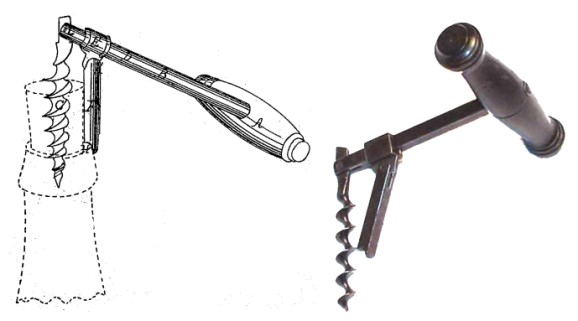
Clapp Patent No. 74,199, February 11, 1868
Button Patent
Gibson Patent
Harrigan Patent
Elijah Button approached the "claw" opening a little differently. He places a spring above the bound wires. The tool is pushed against the bottom of the bottle and that expands the spring. He notes "... by their use that vexatious nuisance, a floating cork, is readily abated." U. S. Patent No. 78,513 was granted June 2, 1868.
George Gibson added a straight pointed wire to presumably pierce the cork to the point where the claws could grasp it. Unlike Clapp's patent, his "spear" does not move up and down. His suggestion that his tool could also be used as a bottle-washer has much more credence with a cloth on the spear and held by the prongs. U. S. Patent No. 89,477 was granted April 27, 1869.
In U. S. Patent No. 117,278 issued July 25, 1871, John Harrigan combines a corkscrew, can opener, and cork-drawer. His "tongs with fangs" store in the handle when not in use. They are not designed to remove a floating cork, rather they grasp a cork when the bottle is turned upside down and the cork falls down into the throat of the neck.
Charles T. Simper's "Cork Pull" was covered by U. S. Patent No. 120,830 issued November 14, 1871. He explains the wires are "so placed that by turning the handle to which they are attached part of them fit inside of the others in order to permit a cork to enter into a concave surface thus formed, when the cork is inclosed [sic] within the wires by turning the handle back again, and thus held secure, may be pulled from the bottle."
Another design incorporating a corkscrew was conceived by Charles Hunt. In his Patent No. 140,706 issued July 8, 1873, the double spring loop slides into the corkscrew handle. Once the springs are inserted into the bottle, Hunt says "... a cork which may have been driven into the bottle can be caught in the loops and withdrawn very easily."
Page / Fahy Patent
Tyrer Patent

Bourg Patent
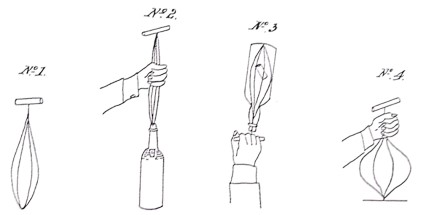
Tyrer Patent
Like Clapp and Gibson, William Page and John Fahy incorporated a center spear in their design. Following Clapp's example, their spear slides up and down and they acknowledge Clapp's patent in their application. They claim the advantage of a shoulder (d) which "insures the prongs being forced down through the neck of and into the bottle." U. S. Patent No. 164,731 was granted June 29, 1875.
A new approach was taken by Australian Peter Tyrer in his U. S. Patent No. 199,760 of January 29, 1878. Tyrer solders the wires at the bottom. Rather than explaining how he actually traps the cork in the center, he simply refers to his drawings and says the cork is taken as shown in figure 2.
Marc Bourg's French Patent No. 134,210 issued December 17, 1879 requires the bottle to be turned upside down like the Tyrer patent but he only used two wires.
Morgan Patent
Engel Patent
Robert Morgan of Stockton, California dispensed with those wires for grasping the cork and came up with a metal shank with teeth. He suggests that the cork will be kept straight by the various projections on the shank but fails to explain how the cork will actually be caught by his device. U. S. Patent No. 270,095 was granted January 2, 1883.
George Engel simplified cork extraction by making his device out of a single rod or wire. He creates a spring action by bending the rod or wire into a spring at the center. His device is not designed for a floating cork - the bottle is turned upside down. U. S. Patent No. 386,005 of July 10, 1888.
Tormey Patent
Tormey Extractor
Bernard Tormey of New York decided to deliberately push the cork into the bottle and retrieve it in his U. S. Patent No. 441,604 or November 25,
1890. His device will reduce to a minimum "the danger of breaking the cork in the act of withdrawing." He provides a tapered end on the handle to force the cork into the bottle.
Above right are two examples of Tormey's Patent. One is 10 3/8" long and the other 11". Some Tormey extractors are marked with the patent date on the shank.
Leupold Patent
Conner Patent
Borg Patent
In Anna Leupold's German Patent No. 174,051 issued January 4, 1906, we find the four finger pull handle in use. In her invention a sleeve slides on the rod which has two points on the end. The cork is righted by the worm and then screwed in. The sleeve is pushed down to engage the cork with the points and then extracted. The patent title is Korkenzieher zum Entfernen von Korken aus dem Flascheninnern.
William Conner's July 14, 1908 U. S. Patent No. 893,055 is very similar to Rosenberry's 1866 patent but with three prongs. He suggests extra duty for his tool with "... it is obvious that the same may be used with equally good results for cleaning bottles, jars, large chimneys and the like by inserting a strip of cotton, sponge or other soft material between the fingers of the spring arm"
Hungarian János Borg received a patent in Hungary on September 6, 1909 for his cork drawer which has a big hook to fish for a fallen cork. On April 27, 1910 he was granted French Patent No. 415,244 and on May 18, 1910 British Patent No. 12,258.
Segger Patent
Puccetti Patent
Sarnecky Patent
In the U. S. patents of Clapp, Gibson, and Page / Fahy a center spear impales the cork to pull it up between the prongs. German inventor Helmuth Segger had an interesting improvement on the concept. He used a screw like spear to flip the cork in between two prongs. A second handle with spring load buttons squeezes the prongs together so the screw can be inserted into the cork, secured by the prongs, and then extracted. German Patent No. 333,808. was issued March 14, 1921 for Korkenzieher mit hilfsvorrichtung zum Herauszeihen von in die Flasche gefallenen Korken (a corkscrew for corks that have fallen into the bottle).
Moses Puccetti was granted U. S. Patent No. 2,145,129 on January 24, 1939. He claimed his cork remover can remove a cork from the neck or a cork that was forced into a bottle. Like a prong puller, he says his tines are fed between the cork and the bottle wall. He then slides the "follower" (18) down so the hooks grip the cork and then it can be extracted. And then he goes on to a concern about the cork falling into the bottle and says the tines are "relatively long and will reach the cork and may be effectively engaged therewith at the hooks"! Evidently he didn't have much faith in his intention to remove the cork from the neck.
The interesting things about Michael Sarnecky's "Picking Tool" is that he never mentions a cork. His primary object was a tool to "grasp articles in places where an individual cannot reach them with his fingers." He says it can be "adapted to be inserted within a bottle or the like and closed upon an object to be removed therefrom." And of particular importance are the finger rings so the tool can be operated with one hand. U. S. Patent No. 2,204,734 was issued June 18, 1940.
The best way: Don't force the cork into the bottle, use a good corkscrew and pull it out!
Retriever / Corkscrew Combos
Here are a couple of other inventions which combined a corkscrew and cork retriever.
Marvin Crannell of Troy, New York patented his invention on May 15, 1877 (U. S. No. 190,669). His object was to create a tool to remove corks "from the neck (of a bottle) or from inside the bottle." The tube covering the worm has spurs to grasp the cork while the worm is being turned in. He suggests the length of the rod may vary depending on the dimensions of the bottles into which a cork has fallen.
Nathaniel Oak of Exeter, Maine also patented a combination corkscrew / cork extractor. His device is very similar to Crannell's and his patent was issued a short time later on November 6, 1877 (U. S. No. 196,761). Crannell filed his application in January, 1877 and Oak in September. Oak claimed "A combined corkscrew and extractor, formed with a central shaft with a spiral point and handle, with surrounding pointed wires mounted in disks, and provided with limited lineal adjustment relative to the central shaft, and to revolve thereon."
Retriever Photos
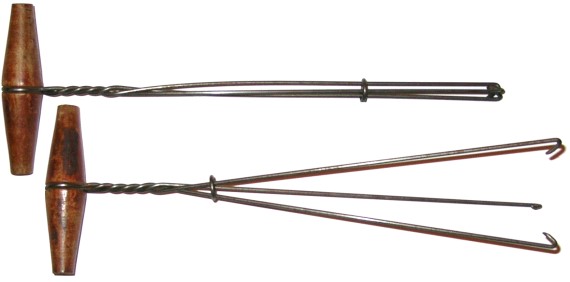
On April 12, 1977 Bernard Bonin of Westbrook, Connecticut was granted U. S. Design Patent No. 244,002. The patent was titled only as a "Cork Retriever" with the only claim being "The ornamental design for a cork retriever, as shown and described" (description is view designations). Although not mentioned, he does provide a handle with one end shaped so a cork could be driven into a bottle - a reminder of the 1890 Tormey patent.
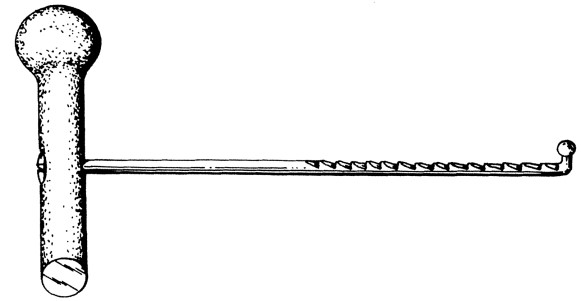
Bonin's Patent
Today's Retrievers
Here are a few of the retrievers currently marketed:
Some home brew supply houses offer this retriever with this advertising copy: "How many times have you pushed a cork into a wine bottle when you were really trying to pull it out? As annoying as it is, the wine will eventually pour out either way, but how are you going to use the bottle again for your next batch of wine? This cork retriever is a handy little device that will grab and pull the cork out with very little time or effort. Very simple to use. The wires expand when in the bottle and contracts when being pulled out."

The Cork Lift
Franmara offers the Corkfish® with this description "Retrieves corks that have fallen into wine bottles. The tubular handle hides a synthetic mesh. This mesh can be placed into the tines of the Corkfish® and inserted into the bottle to remove floating cork fragments in case a cork breaks up. Stainless steel."
Plastic Bag Cork Remover Revisited

In the April 22, 2007 issue we linked to a movie submitted by readers Wayne Meadows and Stephen Hume. So while we're on the subject of corkscre retrievers, watch this movie.
Stage Screw Follow-up
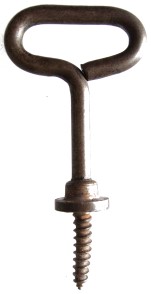
After reading the Stage Screw story in the July 29 issue, reader Hans Turler submitted a photo of his stage screw and wrote "I have a German Stage Screw, which has been used in Bavaria Film Studios in Munich (Germany). Stage screw is Bühnenboher in German. He directed us to the firm Rosco that currently sells equipment, software and products for the theater, film, television, and architectural environments.
On Rosco's German website, they describe the tool as Bühnenbohrer werden genutzt, um Streben oder Kulissenteile am Bühnenboden zu befestigen. Der Bühnenbohrer wird ohne Werkzeug direkt in den Holzboden geschraubt. Der Gewinde-Bühnenbohrer kommt dann zum Einsatz, wenn Kulissen immer wieder exakt an der gleichen Position montiert werden sollen oder wenn besonders feste Verbindungen gefragt sind. Zum Einsatz des Gewinde-Bühnenbohrers wird eine Gewindebuchse in ein vorgebohrtes 14 mm Loch mit einem Schraubendreher eingeschraubt.
And on the U. S. website we find "Stage Screws are used to fasten flats or scenery pieces to the stage floor. The Stage Screw goes directly into the wood stage floor. The Steel Stage Screw should be used when the screw must be used in the same place several times, or where exceptional holding power is needed. To use the Steel Stage Screw, drill a 9/16" hole, screw the Stage Plug into the floor with a wide straight blade screwdriver, then fit the screw into the plug."
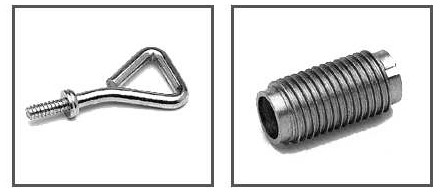
Rosco's stage screw with plug
A Long Extractor

Reader Norm Linn may have the longest packing extractor - his is a little over three feet long! See the July 22 issue for the packing extractor story.
|
©2007 Don Bull, Editor |